Effects of organic fertilizers produced using different techniques on rice grain yield and ammonia volatilization in double-cropping rice fields
2024-03-07MingchengHUAndrewWADEWeishouSHENZhenfangZHONGChongwenQIUandXianguiLIN
Mingcheng HU ,Andrew J.WADE ,Weishou SHEN,* ,Zhenfang ZHONG ,Chongwen QIU and Xiangui LIN
1Jiangsu Key Laboratory of Atmospheric Environment Monitoring and Pollution Control,Collaborative Innovation Center of Atmospheric Environment and Equipment Technology,and School of Environmental Science and Engineering,Nanjing University of Information Science and Technology,Nanjing 210044(China)
2Department of Geographyand Environmental Science,University of Reading,Reading RG6 6DW(UK)
3Haina Research Institute of Guangdong Haina Agricultural Co.,Ltd.,Huizhou 516000(China)
4State Key Laboratory of Soil and Sustainable Agriculture,Institute of Soil Science,Chinese Academy of Sciences,Nanjing 210008(China)
ABSTRACT Ammonia(NH3)volatilization from rice fields contributes to poor air quality and indicates low nitrogen use efficiency.Although organic fertilizers can meet the nitrogen requirement for rice growth,the simultaneous effects of organic fertilizers on NH3 volatilization and rice yield in paddy fields are poorly understood and quantified.To address this gap in our knowledge,experimental field plots were established in a conventional double-cropping paddy field in the Pearl River Delta region,southern China.Five fertilizer treatments were used besides the control with no fertilizer:fresh organic fertilizer,successively composted organic fertilizer,chemically composted organic fertilizer,mixture of chemically composted organic fertilizer with inorganic fertilizer,and chemical fertilizer.Ammonia volatilization was measured using a batch-type airflow enclosure method.No significant differences in grain yield were observed among organic and chemical fertilizer treatments.However,compared with chemical fertilizer,chemically composted organic fertilizer and successively composted organic fertilizer significantly decreased total NH3 volatilization by 70%and 68%,respectively.The ammonium-nitrogen concentration in field surface water correlated strongly(P <0.01)and positively with NH3 volatilization across fertilization treatments.Our findings demonstrate that chemically composted organic fertilizer can sustain rice yield while reducing NH3 volatilization.An important future step is to promote these field measurements to similar rice cultivation areas to quantify the regional-and national-scale impact on air quality and nitrogen deposition in sensitive areas,and to design and implement better fertilizer management practices.
Key Words:air quality,crop production,manure,NH3 emission,nitrogen use efficiency
INTRODUCTION
Rice (Oryza sativaL.) is one of the most important crops globally and a dietary staple for more than half the world population(Bertoraet al.,2018).Rice-planting area covers approximately 1.5×108ha of the land surface on Earth,representing approximately 10%of all cultivated land around the world(Jianget al.,2018).In China alone,which produces and consumes more rice than any other nation,the annual rice-planting area is approximately 3×107ha,which is 23%of the global rice-planting area(Fenget al.,2017;Minet al.,2021b).The use of chemical fertilizers has certainly increased rice production and accelerated economic development.However,long-term application of excessive fertilizers has caused multiple environmental and human health hazards (Linet al.,2007),including the deterioration of soil health,as manifested by soil texture detrimental changes and decreasing soil organic matter content,and excess nitrogen(N)transfer from the plant-soil system to the atmosphere and freshwater and marine ecosystems,thereby contributing to poor air quality,soil acidification,and water eutrophication problems (Kyawet al.,2005;Hayashiet al.,2008).Consequently,the improvement of nitrogen use efficiency (NUE) in rice production is paramount to ensure food security while improving air and water quality.Rice paddy soils are a significant source of ammonia(NH3)volatilization,especially after fertilizer addition(Maet al.,2021).Specifically,NH3volatilization is the process of ammoniumtransformation to NH3in the soil system and subsequent diffusion to the atmosphere (Wanget al.,2007;Heet al.,2018).Furthermore,NH3volatilization is not only a pathway for soil N loss to the atmosphere but it enhances atmospheric N deposition as well,which can adversely impact sensitive ecosystems and cause poor air quality.When NH3enters the atmosphere,it reacts with atmospheric acidic compounds to produce NH4HSO4and other secondary pollutants.Then,through atmospheric transport and deposition,these pollutants can enter wetlands,forests,lakes,grasslands,and other ecosystems,posing high risks of water eutrophication and soil and water acidification (Chatterjeeet al.,2018).Additionally,NH3can react with NOx,SO2,volatile organic compounds,and other substances in the air to generate NH4NO3,(NH4)2SO4,and other particles,which serve as condensation nuclei to further generate PM2.5,thereby promoting the formation of atmospheric haze(Giltrapet al.,2010;Lianget al.,2017;Leeet al.,2021).
China is the largest producer and consumer of N fertilizer globally,and the application rate of N fertilizer accounts for approximately one third of the total amount of N fertilizer used worldwide (Zhaoet al.,2020).Agricultural NUE is reportedly relatively low,with approximately two thirds of the N appliedviafertilizer lost through multiple ways,among which NH3volatilization is a key transfer pathway from the plant-soil system to the atmosphere (Yinet al.,2020).In 2016,the annual NH3emissions in China reached 12.11 million tons with a mean emission intensity of 1.28 t km-2and NH3emissions from N fertilizer application contributed 38%(Liet al.,2021).Fertilizer type,dosage,and application method determine NH3volatilization in paddy fields,with volatilization rate generally between 30%and 70%for ammonium sulfate and ammonium bicarbonate applications and between 20%and 80%for urea application(Islamet al.,2018).Additionally,NH3volatilization waste in paddy fields generally increases with N application rate(Dinget al.,2020).In contrast,fertilizer injection deep into the soil and irrigation after fertilization effectively inhibit NH3volatilization in paddy fields(Liuet al.,2020;Zhonget al.,2021).
Owing to the problems and concerns raised by the excess application of mineral fertilizer,the use of organic fertilizer is receiving increasing attention as a promising green alternative that uses a waste product to replace mineral fertilizer (Sunet al.,2020).Organic fertilizers,primarily made of plant waste and animal manure sometimes mixed with straw,may also include food waste and solid residues from biogas production(Suet al.,2014).Thus,compared with chemical fertilizer,organic fertilizer has many positive effects on paddy fields,including increasing soil C and N,improving soil physical structure,and enhancing crop yield and quality(Dillonet al.,2012;Zhaoet al.,2014).
At the field plot scale,NH3volatilization is highly variable and dependent on multiple factors,including the raw materials used in the production of organic fertilizer,application rate,and fertilization period(Wuet al.,2019;Sunet al.,2020;Minet al.,2021a).However,there are few reports on the effects of organic fertilizers produced by different techniques on NH3volatilization in paddy fields and the few existing ones are primarily focused on the eastern and central regions in China,while studies conducted in southern China are quite rare(Xuet al.,2021).Ammonia volatilization from paddy fields has different regional emission characteristics and depends on organic fertilizer type,application rate,and soil type (Paulotet al.,2014;Liet al.,2021).Therefore,the aim of this study was to quantify the effects of organic fertilizers produced by different techniques on grain yield and NH3volatilization in paddy fields in southern China.To achieve this aim,two objectives were defined.The first was to quantify the effects of conventional chemical fertilizer and various organic fertilizers,all with an equivalent amount of N application,on rice yield,NH3volatilization,and mineral N(i.e.,and nitrate-N)concentrations in field surface water in a double-cropping rice field in the Pearl River Delta region in southern China.The second objective was to consider the outcomes from the experiments in terms of soil fertility improvement,N management strategy,and development of environment-friendly organic fertilizers.
MATERIALS AND METHODS
Studysite
The experimental field was located in Huizhou,Guangdong Province,China(23°1′N,114°5′E)(Fig.S1,see Supplementary Material for Fig.S1).Huizhou has a subtropical monsoon climate,with an average annual temperature of 22°C and an average annual precipitation of 2 200 mm(Fig.1).Typhoon frequently occurs in July and August.Huizhou is the primary rice cropping area of the Pearl River Delta,in which the main rice cultivation pattern is double-cropping,mostly comprising rice-rice-vegetable,rice-rice-potato,or rice-rice-winter fallow.The soil at the study site is an Anthrosol with pH (H2O) of 5.8,organic matter content of 18.6g kg-1,and total N,P,and K contents of 1.1,0.9,and 18.9 g kg-1respectively,as determined by analyzing mixed samples collected from 0-20 cm topsoil.
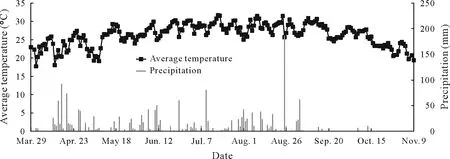
Fig.1 Dynamic variations in precipitation and average temperature during the rice growing seasons in 2019.
Fertilizer manufacture
Chicken manure was selected as raw material for the production of organic fertilizers.Two traditional and a recently developed rapid-composting technology were selected as fertilizer manufacturing methods.The two traditional organic fertilizer manufacturing techniques are fresh organic fertilizer(FOF)and successively composted organic fertilizer(SOF).Fresh organic fertilizer consisted of fresh chicken manure only,which was processed with appropriate physical treatments for convenient transportation and application.In turn,SOFwas produced using a conventional strip-pile composting process.Successive composting has been shown to increase mineralization and humification of organic raw materials,such that the nutrients present can be more easily absorbed and utilized by crop plants (Wanget al.,2017;Fenget al.,2020).In addition,a latest rapid-composting technology(chemically composted organic fertilizer,COF)was used to produce organic fertilizer by addition of a chemical decomposition agent to organic raw materials to promote physicochemical decomposition.Then the manure was heat-treated at high temperatures to kill all pathogenic microorganisms present,and the decomposition rapidly degraded cellulose,hemicellulose,and other substances,thus shortening the ripening time of the organic materials.Finally,a mixture of chemically composted organic fertilizer with inorganic fertilizer(COIF)was produced by adding a chemical fertilizer(urea)to the COF.
Experimental design
In addition to the control with no fertilizer (CK),the following five fertilizer treatments were set up:chemical fertilizer(CF),FOF,SOF,COF,and COIF.The chemical and organic fertilizer treatments had the same N application rate of 105 kg N ha-1.The area of each plot was 42.75 m2(7.5 m×5.7 m),with 4 replicates per treatment.All experimental plots were randomly arranged.To prevent water and fertilizer from moving between adjacent plots,cement ridges were constructed between plots.Chemical fertilizer was divided into basal and tillering fertilizer.Organic fertilizers were applied once only as basal fertilizer and no topdressing was applied(Table I).
Basal fertilizer for early season rice (variety Meixiangzhan 2) was applied on March 29,and rice seedlings were transplanted on March 31,2019.Before transplantation,the seedlings grew for approximately one month.Row spacing for rice planting was approximately 20 cm.Early season rice was harvested on July 15,2019.Late season rice received basal fertilizer on August 8,was transplanted on August 10,and was harvested on November 15,2019.Seedling transplantation,field management,and rice harvest were the same for both early and late season rice,and field management followed the conventional practice of local farmers.Before the experiment,all experimental plots were flooded for one-two weeks,and then cultivated and harrowed,followed by the application of basal fertilizer and transplanting of rice seedlings.For approximately one month after transplanting,the field was flooded,and then there was a period of one to two weeks of mid-season drainage.Following this,the field was flooded again,and then water was drained and the field was dried in the last 10 d of yellow maturity stage to allow rice harvest (Fig.S2,see Supplementary Material for Fig.S2).
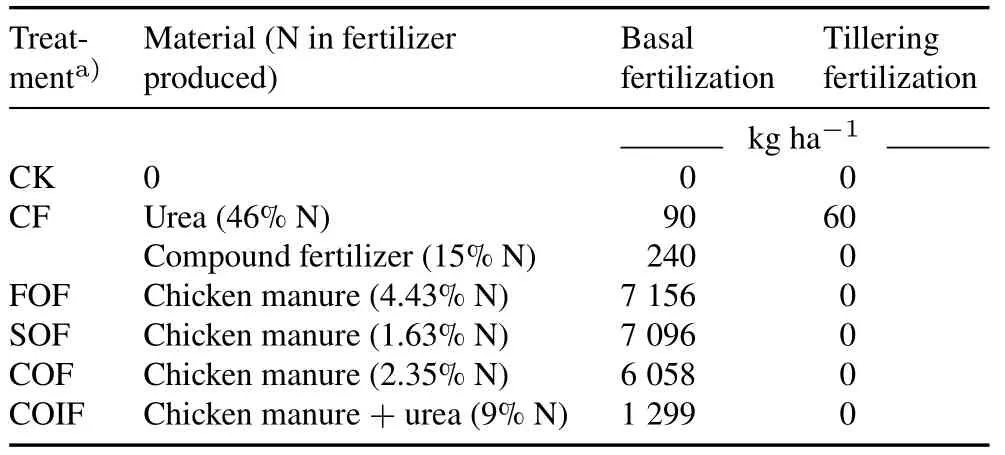
TABLE IFertilizer treatments in each experimental plot
Sample collection and measurement
The NH3volatilization from the experimental plots were collected on each day after fertilization,until no difference was observed between the measurements made in the fertilized and CK plots for more than four consecutive days.During the experiment,NH3gas samples were collected for 4 h (i.e.,7:00-9:00 and 15:00-17:00) every day and daily NH3volatilization flux was calculated based on the 4-h NH3volatilization measured.Total NH3volatilization was calculated by adding the daily volatilization fluxes for the experiment duration,which was 38 d for early season rice and 34 d for late season rice.
The batch-type airflow enclosure method(Donget al.,2019),which is a national standard method,was used to measure NH3volatilization (Fig.S3,see Supplementary Material for Fig.S3).This method uses boric acid to absorb the NH3volatilized from the rice field,and the absorption solution is then titrated with dilute sulfuric acid to obtain the volume of dilute sulfuric acid consumed by titration.The NH3volatilization flux(F,kg N ha-1d-1)was calculated using Eq.1,based on the sulfuric acid volume used for titration(V,mL)(Zhonget al.,2021):
where 10-3is the volume conversion factor,Cis the calibration concentration of sulfuric acid for titration (mol L-1),0.014 is the relative atomic mass of N atom (kg mol-1),104is the area conversion factor,Ris the radius of the air chamber(m),and 6is the ratio of 24 h to the daily NH3volatilization collection time.
Field surface water samples were collected,using the five-point sampling method,throughout both the early and late season rice growing periods.Briefly,100 mL of surface water was collected from five points in each plot to produce a composite sample.The surface water was sampled on 1,2,3,6,10,15,21,27,and 38 d after the application of basal fertilizer for early season rice.For late season rice,the sampling frequency of surface water was once a day after the application of basal fertilizer,and 34 samples were collected.On each sampling day,water samples were transported promptly to laboratory for measurements ofandconcentrations and pH.
Statistical analysis
The least significant difference method following oneway analysis of variance,implemented in the IBM SPSS Statistics 21.0 software,was used to analyze the significance of any differences in rice yield,NH3volatilization flux,and cumulative NH3volatilization among the five different treatments and CK.
RESULTS
Rice yield
Annual rice yield was the largest in FOF,followed by COIF,CF,COF,and SOF,while the lowest yields were recorded in CK(Table II).Fertilizer treatments significantly enhanced(P <0.05)rice yields for both early and late season rice,compared to CK.For early season rice,except for SOF,FOF,COF,and COIFincreased(P >0.05)rice yields by 4.0%,3.1%,and 2.0%,respectively,in comparison with CF.For late season rice,COIFand FOFincreased(P >0.05)rice yield by 4.2%and 2.6%,respectively,compared with CF.In general,the yield of late season rice was higher than that of early season rice,and there was no significant difference between CFand the four organic fertilizer treatments for annual rice yield(Table II).

TABLE IIYields of early and late season rice in 2019 under six fertilizer treatments:no fertilizer(control,CK),chemical fertilizer(CF),fresh organic fertilizer (FOF),successively composted organic fertilizer (SOF),chemically composted organic fertilizer(COF),and mixture of chemically composted organic fertilizer with inorganic fertilizer(COIF)
NH3 volatilization fluxfrom double-cropping rice field
The NH3volatilization fluxes were notably higher for the fertilizer treatments than for CK during early season rice growing period,with NH3volatilization occurring mainly within one week after basal fertilization(Fig.2a).The NH3volatilization fluxes peaked on the first day after fertilization and then gradually decreased on the second day and thereafter.A second NH3volatilization flux peak occurred on the 6th day after fertilization,and then gradually decreased to the background level.There was no obvious peak in NH3volatilization flux after tillering fertilization with chemical fertilizer on April 16,2019.Only two small NH3volatilization flux peaks occurred 20 and 26d after fertilization in COIFand SOF,respectively.Among all treatments,the peak NH3volatilization flux was the highest for COIF,followed by COF,CF,FOF,and SOF,while the lowest peak was recorded for CK(Fig.2a).Late season rice NH3volatilization was also concentrated mainly in the first week after basal fertilization(Fig.2b),which was consistent with the volatilization emission timing of early season rice.The NH3volatilization fluxes peaked on the first day for COIF,on the second day for FOF,COF,and SOF,and on the third day for CFafter basal fertilization for late season rice (Fig.2b).The NH3volatilization fluxes dropped on the fourth day(August 11,2019)for all treatments owing to a heavy rainstorm.After tillering,chemical fertilizer was added on September 1,2019,and the NH3volatilization flux increased rapidly,peaked on the second day after supplemental fertilization,and then declined to the background level.Of the six treatments tested during the late season rice growing period,the peak NH3volatilization fluxes were the highest for COIF,followed by CF,FOF,COF,SOF,and CK(Fig.2b).
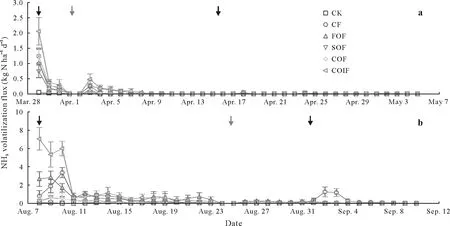
Fig.2 NH3 volatilization flux from field plots under six fertilizer treatments,no fertilizer(control,CK),chemical fertilizer(CF),fresh organic fertilizer(FOF),successively composted organic fertilizer(SOF),chemically composted organic fertilizer(COF),and mixture of chemically composted organic fertilizer with inorganic fertilizer(COIF),during early(a)and late(b)season rice growing periods in 2019.Vertical bars indicate standard deviations of the means(n=4).Black arrow indicates fertilization,and grey arrow indicates typhoon that caused the experiment to be suspended.
Cumulative NH3 volatilization and NH3 volatilization intensityin paddyfields
In early season rice growing period,cumulative NH3volatilization was the highest for COIF,followed by CF,COF,FOF,SOF,and CK (Table III).The four organic fertilizer treatments and CFsignificantly increased (P <0.01) cumulative NH3volatilization compared with CK;however,cumulative NH3volatilization decreased (P <0.05) by 24.9%,38.5%,and 38.7% in COF,FOF,and SOF,respectively,and increased by 54.9%(P <0.05)in COIF,compared with CF(Table III).Further,cumulative NH3volatilization was the greatest in COIF,followed by FOF,CF,SOF,and COF,while it was lowest in CK in late season rice growing period (Table III).Cumulative NH3volatilization significantly increased(P <0.01)in COIF,FOF,and CFcompared with CK.Furthermore,cumulative NH3volatilization in SOFand COFsignificantly decreased(P <0.01) by 72.7% and 77.6% respectively,compared with CF;however,cumulative NH3volatilization in COIF significantly(P <0.01)increased by 79.8%compared with CF(Table III).
The combined effect of different fertilizers on rice yield and NH3volatilization was evaluated by calculating NH3volatilization flux per unit rice yield,i.e.the NH3volatilization intensity(Yanget al.,2020)(Table III).For late season rice,the NH3volatilization intensity was much higher than that for early season rice.Total NH3volatilization intensity of early and late season rice was the highest for COIF,followed by CF,FOF,SOF,and COF,and the lowest in CK.Moreover,NH3volatilization intensity for early and late season rice decreased by 1.9% (P >0.05),64.7% (P <0.01),and 67.9% (P <0.01) for FOF,SOF,and COF,respectively,compared with CF.

TABLE IIICumulative NH3 volatilization and NH3 volatilization intensity during early(ESR)and late(LSR)season rice growing periods in 2019 under six fertilizer treatments:no fertilizer(control,CK),chemical fertilizer(CF),fresh organic fertilizer(FOF),successively composted organic fertilizer(SOF),chemically composted organic fertilizer(COF),and mixture of chemically composted organic fertilizer with inorganic fertilizer(COIF)
Relationships between NH3 volatilization fluxand and pH in field surface water
The NH3volatilization flux increased with higherN concentrations in field surface water.For both rice growing seasons,the changes inconcentration in the surface water for the different treatments had a linear relationship with the changes of NH3volatilization flux (Fig.3).The maximumconcentration in field surface water appeared within one week after basal fertilization.Similarly,theconcentration in field surface water increased significantly after tillering fertilization in CFand then decreased gradually(Fig.4).All chemical and organic fertilizer applications significantly increased theconcentration in field surface water compared with CK for both early and late season rice.Linear regression analysis showed a strong correlation between NH3volatilization flux and theconcentration in field surface water for both chemical and organic fertilizer treatments.Except for CK for late season rice,Pvalues of all other treatments were less than 0.01,and the correlation coefficientrranged between 0.72 and 0.99(Fig.3).
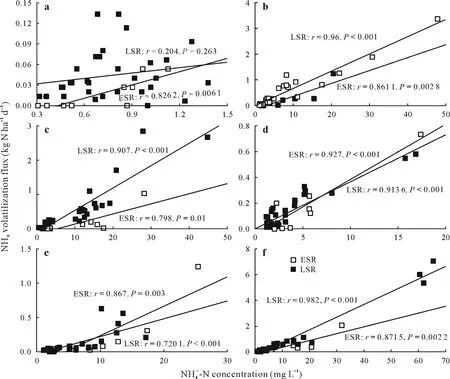
Fig.3 Relationships,as determined by linear regression analysis,between NH3 volatilization flux and concentration in field surface water in early(ESR)and late(LSR)season rice growing periods in 2019 under six fertilizer treatments:no fertilizer(a),chemical fertilizer(b),fresh organic fertilizer(c),successively composted organic fertilizer(d),chemically composted organic fertilizer(e),and chemically composted organic fertilizer with inorganic fertilizer(f).
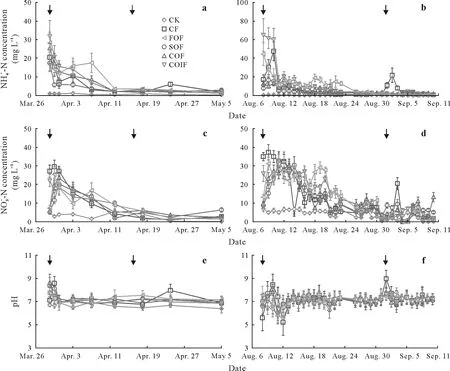
Fig.4 Concentrations of and and pH values in field surface water in early(a,c,and e)and late(b,d,and f)season rice growing periods in 2019 under six fertilizer treatments:no fertilizer(control,CK),chemical fertilizer(CF),fresh organic fertilizer(FOF),successively composted organic fertilizer(SOF),chemically composted organic fertilizer(COF),and chemically composted organic fertilizer with inorganic fertilizer(COIF).The arrow indicates fertilization.
TABLE IVCorrelation coefficients of NH3 volatilization flux with concentration,concentration,and pH in field surface water,air temperature,soil temperature(5 cm depth),and precipitation during early(ESR)and late(LSR)season rice growing periods

TABLE IVCorrelation coefficients of NH3 volatilization flux with concentration,concentration,and pH in field surface water,air temperature,soil temperature(5 cm depth),and precipitation during early(ESR)and late(LSR)season rice growing periods
*,**,and***Significant at P <0.05,P <0.01,and P <0.001,respectively.a)CK=control with no fertilizer;CF=chemical fertilizer;FOF=fresh organic fertilizer;SOF=successively composted organic fertilizer;COF=chemically composted organic fertilizer;COIF=mixture of chemically composted organic fertilizer with inorganic fertilizer.
The pH in field surface water first increased and then decreased after basal fertilization in early and late season rice growing periods(Fig.4).Specifically,pH increased from 5.60 on the first day to 7.45 on the second day and to 8.45 on the third day,and then gradually decreased after the basal application of chemical fertilizer for late season rice(Fig.4).Higher pH for all organic fertilizer treatments was observed mostly in the first three days after basal fertilization,and the NH3volatilization peak flux coincided with this stage for all the organic fertilizer treatments.The pH range of field surface water was smaller for the organic fertilizer treatments than for CF(Fig.4).The correlation between NH3volatilization flux and pH in field surface water in early season rice was higher than that in late season rice,which was significant in SOF(P <0.05),COF(P <0.01),and COIF(P <0.01)(Table IV).
Effects of meteorological factors on NH3 volatilization
Mean air temperature over the experimental period for NH3volatilization in early season rice was 22.9°C,which was lower than that(28.8°C)for late season rice(Fig.1).Similarly,soil temperature (5 cm depth) in early season rice growing period was lower than that in late season rice growing period,and precipitation during early rice experimental period was more continuous and frequent than that during late season rice growing period.There were 29 rainy days out of 38 days for early season rice growing period,with a mean precipitation of 16.5 mm,and 18 rainy days out of 34 days during the late season rice growing period,with a mean precipitation of 14.1 mm(Fig.S4,see Supplementary Material for Fig.S4).Correlation analysis showed that there was a negative correlation (P >0.05)between precipitation and NH3volatilization flux in the field experiments.In contrast,there was a positive correlation between air temperature and NH3volatilization flux in SOF(P <0.05),COF(P <0.05),FOF(P <0.01),and COIF(P <0.01) in late season rice growing period.Finally,soil temperature and NH3volatilization flux also showed a positive correlation(P <0.01)for the chemical and organic fertilizer treatments for late season rice(Table IV).
DISCUSSION
Effects of organic fertilizers on rice yield
Rice yields in FOF,SOF,and COFdid not significantly differ(P >0.05)from that in CF.This is a significant outcome,indicating that the three organic fertilizer treatments tested herein have the potential to replace chemical fertilizers.In this study,FOFhad a positive effect on maintaining rice yield,and this form of organic fertilizer has the advantages of simplicity,convenience,and low production cost(Donget al.,2019).However,the direct application of untreated manure may lead to the emission of harmful gases such as H2S and CH4,the latter being a greenhouse gas(Fenget al.,2020).Moreover,untreated manure may introduce pathogenic bacteria and weed seeds to the paddy agroecosystem(Amin,2020),and cause high NH3volatilization(Table III).For these reasons,the direct application of fresh manure is not recommended at a large scale.Alternatively,the use of SOFalso maintained rice yield relative to CF,although the production time was longer than that of COF.In contrast,COFnot only maintained rice yield and reduced NH3volatilization relative to CF,but also offered the benefits of pathogen sterilization,weed seed treatment,and a short production cycle.Thus,COFhas good prospects for widespread application in the double-cropping rice fields with a similar climate and soil type as reported herein.
Effects of organic fertilizers on NH3 volatilization from double-cropping rice fields
The application of both chemical and organic fertilizers increased NH3volatilization loss from the double-cropping rice fields in this study,indicating that the addition of exogenous inorganic and organic N increased NH3volatilization,consistently with previous reports(Zhaoet al.,2015,2021).Furthermore,COIFsignificantly increased NH3volatilization for both early(by 54.9%)and late(by 79.8%)season rice compared with CF(Table III).A possible reason for the increased volatilization observed in this case may be that COIFconsisted of two parts,inorganic N fertilizer with urea and compound fertilizer and organic N fertilizer(COF).The urea addition increased mineral N content and then rapidly increased theconcentration in field surface water,which in turn stimulated higher NH3volatilization(Sunet al.,2019;Leeet al.,2021).The NH3volatilization was also higher after the application of FOFfor both early and late season rice(Fig.2).As FOFwas made with fresh untreated chicken manure,the number of microorganisms was surely exceedingly large(Fenget al.,2017),whereby organic N present in FOFwas likely soon converted to mineral N through microbial decomposition,thereby increasing theconcentration and NH3volatilization(Liuet al.,2015;Leeet al.,2021).The NH3volatilization period in FOFwas longer than those in the other organic fertilizer treatments during late season rice growing period,because theconcentration in field surface water remained at a higher concentration for a long period(Fig.4).
The main reason for the reduced NH3volatilization in COFis surely that the organic materials were completely fermented and decomposed during the process of fertilizer production.With most of readily decomposed organic N consumed during fermentation,the remaining organic N was presumably difficult to degrade,which would account for the low NH3volatilization flux.Moreover,as most microorganisms in chicken manure were killed in the COF production process by high temperature sterilization,the generation of mineral N may have taken a long period after the application of COF.Similarly,most of the degradable organic N in organic materials is consumed by composting and fermentation;thus,the mineral N content in SOFis low,thereby reducing the volatilization of NH3from rice fields(Leeet al.,2021).
Factors influencing NH3 volatilization from double-cropping rice fields
The pH in field surface water is another significant factor affecting NH3volatilization from double-cropping rice fields(Maet al.,2021).Consistent with the findings of Zhonget al(2021)and Sunet al(2019),this study also showed a positive correlation between field surface water pH and NH3volatilization(Table IV).
Meteorological variables,such as temperature,precipitation,wind speed,and incident solar radiation,may also affect NH3volatilization in paddy fields,but these appear to be second-order effects when compared to fertilizer addition.In general,sunny weather conditions with high temperature,less precipitation,high wind speed,and strong light intensity tend to promote NH3volatilization loss in paddy fields(Kumagaiet al.,2011;Xuet al.,2021).Conversely,lower temperatures reduce the hydrolysis rate of urea and organic N,inhibit the formation ofslow down the conversion ofto NH3,and reduce the transport and diffusion of NH3at the water-air interface,ultimately resulting in the reduction of NH3volatilization in paddy fields(Xiaet al.,2020).In turn,abundant precipitation might decrease theconcentration in field surface water and increaseloss through runoffand leaching,thus accounting for the decrease in NH3volatilization in paddy fields(Heet al.,2018).Among all treatments for early season rice,almost no NH3volatilization occurred after April 9,2019 because of the low temperature and rainy weather conditions(Figs.1 and 2a).The distinctive climatic conditions with typhoon,wet and rainy weather,and high temperature and heat in the Pearl River Delta region would interfere with the normal operation of field experiment(Chenet al.,2015).In the late season rice growing period,the experimental field was completely flooded after a heavy rainfall on August 11,2019,resulting in a sharp decline in NH3volatilization fluxes.Nearly two weeks later,the NH3volatilization experiment was forced to stop due to the rainstorm caused by typhoon“Bailu”,underwhich 186mm of rainfall fell within 24 h.In addition,the typhoon“Lingling”caused the NH3volatilization flux in CFto decrease rapidly back to the background level on the fourth day after tillering fertilization(Fig.2b).Therefore,the cumulative NH3volatilization from rice fields may be lower than the actual value.
It should be pointed out that due to adverse factors such as the COVID-19 pandemic,the study on the mechanism of NH3volatilization in rice fields could not be conducted in depth.This study did not analyze the relationships between soil properties,such as,pH,and,and NH3volatilization in paddy fields.At the same time,the activity and gene abundance of soil microorganisms closely related to NH3volatilization in rice fields and the activity of important enzymes,such as urease,were not analyzed.We hope that in our follow-up study,we will further study the mechanism of NH3volatilization and better explain the effect of organic fertilizer on NH3volatilization in paddy fields.
Overall,in this study,the two organic fertilizers produced by successive composting and the latest rapid composting organic fertilizer showed promising effects on ensuring rice yields and mitigating NH3volatilization from rice fields(Tables II and III).Compared with COF,SOFshowed almost consistent positive effects on maintaining rice yield and reducing NH3volatilization in paddy fields.However,given the shorter production cycle of COF,approximately one month shorter than that for SOF,and pathogen sterilization,COFseems worthy of further investigation for rice production at a large scale.
CONCLUSIONS
There was no significant difference(P >0.05)in rice yield between chemical fertilizer and four organic fertilizer treatments.Organic fertilizers COFand SOFproduced the same rice yield as that when chemical fertilizer was used in a double-cropping rice paddy field,while reducing NH3volatilization.The NH3volatilization loss from late season rice field was much higher than that from early season rice field.Total NH3volatilization from early and late season rice fields significantly decreased after application of COF(by 70%)and SOF(by 68%),compared with chemical fertilizer.Theconcentration in field surface water was a critical factor(P <0.01)determining NH3volatilization from paddy fields.Overall,COFmaintained rice yield,mitigated NH3volatilization from paddy fields,and showed the additional benefits of pathogen sterilization,weed suppression,a shorter production time,and utilization of chicken manure,thus contributing to develop a N circular economy.The next step of investigation is recommended to develop the widespread use of COFover large regions to promote a higher NUE in agriculture and help minimize N losses to the environment.
ACKNOWLEDGEMENT
This study was funded by the National Natural Science Foundation of China(No.41771291),the Agricultural Science and Technology Innovation Fund of Jiangsu,China(No.CX(21)3183),the Specially-Appointed Professor Program of Jiangsu,China,the Six Talent Peaks Project in Jiangsu Province,China(No.NY-083),and the Startup Foundation for Introducing Talent of NUIST,China.
SUPPLEMENTARY MATERIAL
Supplementary material for this article can be found in the online version.
杂志排行
Pedosphere的其它文章
- Developing the new soil science-Advice for early-career soil scientists
- Biophotoelectrochemistry:An emerging frontier for channeling photoelectric effect into darkness zone of soils and sediments
- Balancing machine learning and artificial intelligence in soil science with human perspective and experience
- Soils in extraterrestrial space:Need for studies under microgravity
- Role of biochar in raising blue carbon stock capacity of salt marshes
- Long-term fertilizer nitrogen management-Soil health conundrum
